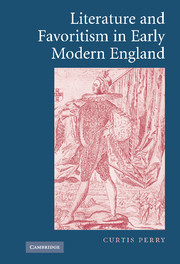Book contents
- Frontmatter
- Contents
- Acknowledgments
- A note on texts
- 1 “Prerogative pleasures”: favoritism and monarchy in early modern England
- 2 Leicester and his ghosts
- 3 Amici principis: imagining the good favorite
- 4 Poisoning favor
- 5 Erotic favoritism as a language of corruption in early modern drama
- 6 “What pleased the prince”: Edward II and the imbalanced constitution
- 7 Instrumental favoritism and the uses of Roman history
- Afterword: “In a true sense there is no Monarchy”
- Notes
- Index
Afterword: “In a true sense there is no Monarchy”
Published online by Cambridge University Press: 22 September 2009
- Frontmatter
- Contents
- Acknowledgments
- A note on texts
- 1 “Prerogative pleasures”: favoritism and monarchy in early modern England
- 2 Leicester and his ghosts
- 3 Amici principis: imagining the good favorite
- 4 Poisoning favor
- 5 Erotic favoritism as a language of corruption in early modern drama
- 6 “What pleased the prince”: Edward II and the imbalanced constitution
- 7 Instrumental favoritism and the uses of Roman history
- Afterword: “In a true sense there is no Monarchy”
- Notes
- Index
Summary
The idea of impersonal royal love, the love of a ruler for his or her subjects in general, is a fully conventional aspect of the idea of monarchy in early modern England. One thinks of the affectionate rhetoric of Elizabeth's so-called golden speech, of James's paternalism, or of the emphasis upon love as government so characteristic of the Caroline court. In a suggestive essay, Judith Richards has traced the increased prominence given to this idea of royal love within the affective rhetoric of monarchy from the early sixteenth century on, arguing that this language began then to crowd out a more specifically feudal vocabulary of specific duties and allegiances. The importance of this change in emphasis has to do with the way subjects are imagined to relate to the crown and to participate in the nation as an imagined community: the language of impersonal royal love offers (at least notionally) a model of state in which English subjects are tied to their monarch not by traditional duties of rank or position but by a more undifferentiated and inclusive kind of sentimental bond. Conceiving of the polity in these terms likewise conjures up a vision of the ideal monarch, one for whom personal and particular forms of love and favor are replaced by an impossibly general love and under whom impartial distributive justice replaces more specific structures of allegiance.
- Type
- Chapter
- Information
- Literature and Favoritism in Early Modern England , pp. 276 - 285Publisher: Cambridge University PressPrint publication year: 2006



